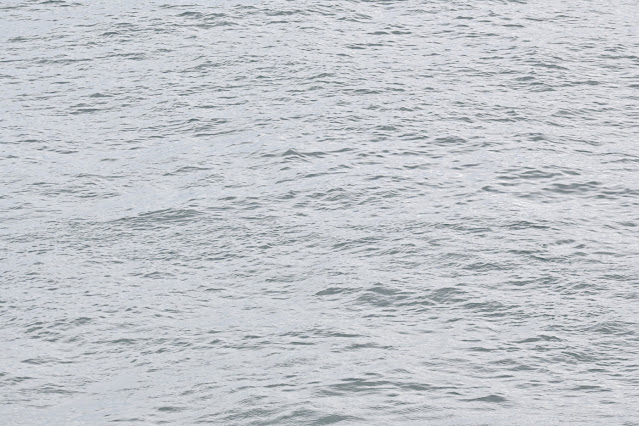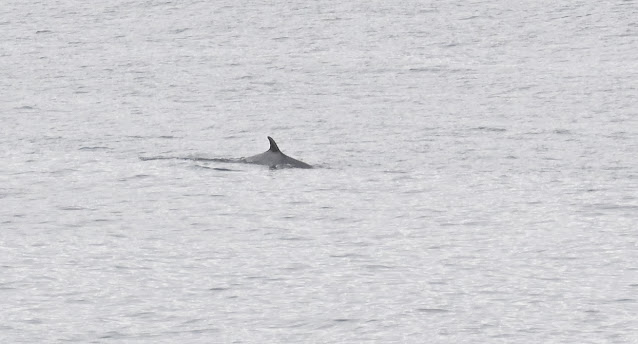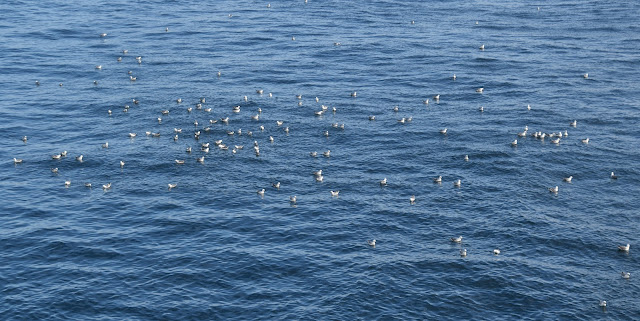The Safari was invited by old Southside friend AB on an adventure much further afield recently. We headed down to Liverpool to join the cruise ship Borealis as one of the wildlife guides for Ocean Wildlife Encounters. This was our second adventure aboard this ship with OWE, the previous one was a rather rough and windy jaunt to eastern Canada last October which sadly we've not written up for you. Lots of brilliant wildlife was seen despite the bad weather and this cruise promised just as much in, hopefully, far better conditions.
 | ||
| Borealis at Pier Head Liverpool |
We've no idea how they saw the fish but they barely touched the surface to catch them and swallowed them within milliseconds.
After a fair old feast in the buffet restaurant it was time to don the fetching purple official OWE tabard and start work as the ship began to move off its berth. Our route would take us past the west side of the Isle of Man, through the North Channel then out into the Atlantic south of St Kilda.
Our mission was to show as many of our fellow passengers as much wildlife as we possiblly could from shoals of Jellyfish to Blue Whales. And everything else in between...fingers crossd on the latter as we'd badly dipped one on the Canada trip. One thing we hoped for was plenty of petrels, particularly Storm Petrels, as we've only seen them once before. As luck would have it and would it be an omen we did see a Petrel almost straight away but it was 'just' the river pilot's boat come to see us safely through the channel out into the bay.
Working our way out of the River Mersy and into Liverpool Bay there wasn't much happening, excitement rose considerably when a small flock of Oystercatchers then a lone Woodpigeon flew across in front of us. No Harbour Porpoises we found nor were ther any Grey Seals on their favoured haul-out sandbank whcih had only just been uncovered by the dropping tide. In fact much of Liverpool Bay was devoid of life, there were very few Kittiwakes, just one reasonable sized flock of Manx Shearwaters with precious few others, just a handful of Gannets and very sadly far more dead ones than live ones - bird flu victims? - a solitary Fulmar, no skuas, no divers, no terns, no Common Scoters, no Little Gulls; it was very quiet out there. Best was a snall flock of about a dozen Golden Plovers whizzing past the observation area.North of the Isle of Man we came across the first auks, small flotillas of Guillemots scattered here and there and we hit our first blubber, with a least two Bottlenose Dolphins been seen.
Rain showers were a feature of the morning of Day 2 but they faded away to give long sunny spells by the afternoon.New birds for the trip today included a few Razorbills and the first of many Puffins with a few Sooty Shearwaters and Great Skuas.There were many more Manx Sheawaters and Guillemots too and everywhere we looked there were Fulmars.
Many years ago (c40) we'd apparently mentioned to OWE colleague IH during a ferry crossing to Ireland that Fulmars didn't eat, no-one had actually ever seen one eat anything at all. And since that time we both shook our heads and said "no, never seen any Fulmar eat anything since then either". So it must be true. Although discussions took us to decide that they actually keep the planet safe by eating Marine Dark Matter at night, converting it into Visible White Matter and safely disposing of it during the day. Note how carefully the bird is trying to keep our oceans clean by ejecting the VWM into the air away from the water.
Good to see far more live Gannets than dead ones today too...a big relief really.
We also saw our Storm Petrels, several small groups...brilliant but a nightmare to photograph such a tiny scrap of feathers from so high up on the ship so please excuse the poor pics.
St Kilda loomed in the distance when we spotted a lone Leach's Petrel.The only Grey Seals of the trip were seen today, just two, a brief sighting of one diving well away from the boat and one that swam beneath our bow. We see those regularly off the prom close to Base Camp but a 'wobbly old-fashioned school ruler' was something we've only ever seen once before and nowhere near Base camp - the tall dorsal fin of a Sun Fish.
As for finned blubber an odd cloud in the shape of a whale's tail was a good omen.
Passing beyond St Kilda we had pods of Common, Bottlenose and White-beaked Dolphins a couple of Minke Whales and Long-finned Pilot Whales, some passengers reported seeing Harbour Porpoises in the flat calm sea too. At dusk a series of blows on the port side...getting all nautical now...alerted us to a couple or maybe even three logging Sperm Whales...job done...get in!
At dusk a series of blows on the port side...getting all nautical now...alerted us to a couple or maybe even three logging Sperm Whales...job done...get in!Our third day brought more showers on a cool breeze but still only a slight sea. We now had a 'Big Four' thing going on; Fulmars, Kittiwakes, Puffins and Gannets were pretty much ever-present in varying numbers all day but bird-wise the shearwaters were the stars today, plenty of Manxies, 5 Sootys and more Great Shearwaters than you could shake a stick at. We also had a Blue Fulmar and small flcoks of Arctic Terns along with couple of juvenile Black Headed Gulls well away from land and going even further away. Auks were not so well represented other than the Puffins but several distant tiny blobs of black and white zooting through the troughs could only have been Little Auks...it took a while to get a handle on them and they were impossible to photograph but it wasn't until we realised they were still in breeding plumage that we worked out what they were.
Out in the middle of nowhere a Turnstone turned up on the bow and pottered around in front of several admirers for an hour or so. It really shouldn't have stayed so long as it was now at least 30 miles closer to where it had come from than where it was going to.
Talking of Fin Whales, we saw lots, well lots of blows and some of them were close enough to resolve into a bit of the animal.
The Fin Whales had a supporting cast of Minke Whales
For an hour or so we had the cruise's Special Guest Speaker join us (as if AB wasn't special enough!) she came up for a chat and a bit of an interview thing as well as joining in with the watching. She's probably familiar to many of you. here's a screenshot of her Twitter (now X) feed from that day.
 |
| From L-R The Safari, Michaela S, IH |
She certainly filled her boots with cetacean sightings while watching with us but we just couldn't rustle up the Blue Whale she really wanted. Good of her to be wearing an almost matching uniform too.
A grand day out on the beautiful briny sea and getting ready for a bit of land-lubbering tomorrow.
Day 4 saw us dock just offshore at Heimaey Island a few miles off the SE corner of Iceland. A small island which had suffered an almost catastrophing volcanic eruption in the early 1970's. It was a warm and sunny day, t-shirt sleeves weather.
While waiting for the tenders to take us to shore we watched from Deck 3 to see what we could see and mostly it was Fulmars...the ship was surrounded by them giving some good photo opportunities.A Wheatear was briefly hopping around the boat while White Wagtails flew back and forth overhead. Further away from the boat we had an Arctic Skua, a couple of Great Skuas sadly not as close as the Fulmars.
There were plenty of Kittiwakes and Puffins and a Minke Whale was fairly close too our mooring position too
In the distance across the bay over on the mainland an extinct volcano had attracted a cloud 'in perfect harmony', looking just like the real thing!
Eventually it was our turn to head for shore for a bit of sightseeing. Black Guillemots welcomed us as we sailed towards the harbour entrance while Glaucous Gulls soared overhead. The ride also gave the chance to get some eye level pics of the Fulmars sat on the water but keeping them in the frame as the little boat wallowed around in a rather large swell was tricky to say the least.
It was a warm day and the popular walk up the volcasno that nearly destroyed the town was given the thumbs down so we had a lower level wander around the larva fields it buried half the town with. There were some poignent signs indicating where former homes stood now buried in 30 feet of basalt. We heard Meadow Pipits and saw a flock of pigeons, or rather Rock Doves - we've never seen such a large flock of pigeons in which almost all were the original 'wild type'.
The rocky larva field had some weird and wonderful shapes and in its crevices grew some interesting plants.

We're not sure what those plants are but they seem familiar and we feel we ought to know them.
After a curcuit of the lower boulder fields we weren't sure where to head for next when another passenger told us of the old church and there was a bit of a sandy bay beyond where they had seen some unidentified waders so that made our mind up for us and off we went down the hill.
Or the singing cave where tourist boats moored up for the occupants to have a warble in the fantastic acoustics. Looking above the cave you can just make out a small house ands an overhang with some neets - we think this is probably a Puffin hunter's lodge. Sadly Puffin is still very much on the menu for the locals and also in some more touristy restaurants. The Safari prefer's Puffins alive and kicking rather than sat on a plate surrounded by spuds and gravy...even though despite being black and white they're not one of our favouritest birds, we can take em or leave em unlike Mediterranean Gulls, Coots, Moorhens, Swifts, Leach's Petrels etc etc...
To the left and towering above the back of the harbour is this impressive cliff with its weird hanging rock which is probaly very solidly attached! But look below it and you'll see a well made dry stone wall - what on earth is that for and how did they build it cos there's no stones nearby so they must have been specially carried up and then lowred down. We thought they maybe for a shelter for collecting seabirds from but as you can see the cliff has no guano so it's not used as a nesting site. How odd!!! Any ideas folks...
It was here that MS bumped into us and we ended up having a good old chat whilst showing her the wonders of Great Skuas and Glaucous Gulls passing up and down the channel and soaring over the hillside above.
Back in the harbour we had marvelous views of a Black Guillemot swimming in the crystal clear water right below our feet, a fantastic sight, well worth the whole trip just for those few minutes. Would ya look at those feet!
One place we've always been fascinated by is the Island of Surtsey, it's one of our earliest memories watching black and white telly of it bubbling up molten hot from out of the sea forming new land way back in 1963 and as luck would have it we sailed right around it, well the best part of three sides anyway. Fabulous although it doesn't look much in my pic just being there was good enough for us as it's a place we've always wanted to see. The colours, random huge rocks scattered about and different strata in the rocks all told the story of a new land being formed, and new it is as there's still very little vegetation able to get a toe-hold on the there.Leaving Surtsey behind we sailed on past some other volcanic rock formations jutting out of the sea.There still some daylight hours for us to watch the sea but it was fairly quite other than the Big Four seabirds, Kittiwakes, Puffins, Fulmars and Gannets. AB managed to get his attendent passengers on to a couple of Blue Whales, unfortunately our radios were having charging issues and one working one is no good really so by the time a runner had been sent to our side of the ship and we'd raced across there was nothing to see. Luckily there were plenty of Fin Whales both sides of the ship for us to point out to the passengers. Not a dolphin nor a seal in sight though which we thought a little odd, where were they?
The first birds you see from the ship are the Eiders in the harbour and these brightly coloured beauties.Which are not to scale we hasten to add. Clockwise from the top Common Redpoll, Goldcrest, Wren, Redwing, White Wagtail, and (we're guessing) Honey Bee.
Down at the waterside we made our way to the arty Viking longboat known as the Sun Voyager.
In the bay adjacent a small group of Arctic Terns fished andd further along towards our bus stop a Glaucous Gull probed the seaweed for whatever edible might be lurking beneath.And we discovered a new species of gull, one we really should have taken a second mortgage out to try.There was one thing in Iceland we really didn't expect to see not that we had any expectations of what we might see anyway. Back on the boat after lunch and having a much round looking off Deck 3 the clouds behind us looked really ominous - it wor black o'er Bill's mother's or as black as the obs of hell as they say. We were half way through thinking if we saw that at home lightning would come from that part of the cloud...but before we could finish the thought lightning did indeed come from the part of the ccloud we would have expected it to. Now we don't know too much about the climate of Iceland other than it's cold, well colder than here and we don't get that many thunderstorms here so they probably get far fewer. Earlier, at the park lake, we'd chatted to a local family about nearby birding sites and they told us it was a very hot (by their standards) day, it was comfortably t-shirt sleeves weather about 18 or 19C so maybe just warm enough to set off a thunderstorm. researching Iceland thunderstorms on the tinterweb back at Base camp we learned they only have between 250 and 600 lightning strikes a year and we saw five of them!The area directly behind the long low bright white building to the lerft of the ship took the brunt of the storm. It was a good few minutes between strikes so even though we tried to video the action on our phone we missed the stikes by stopping recording too soon. We've never managed a pic of lightning, usually we're abroad when we try and get everything set up and then sleep through the storm before turning the camera on...worra numpty!
A big shout out to John Riley from Yorkshire for letting us use his fabulous pics.
 |
| White Beaked Dolphins with a Fin Whale beyond |


















































































No comments:
Post a Comment